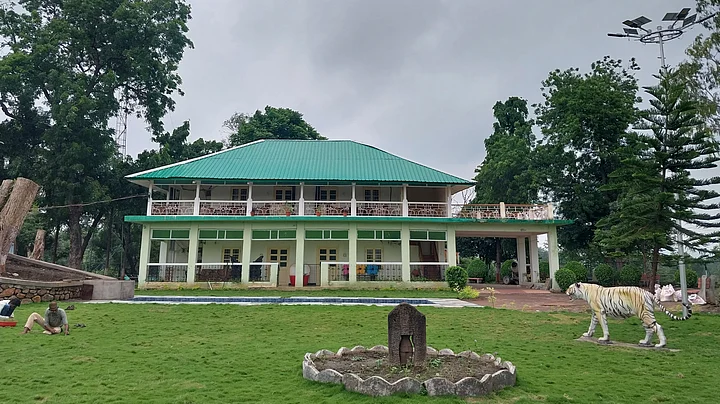One morning, as this reporter was in the middle of a conversation with Bishnu Saha, the caretaker in charge of the Sukna forest rest house near Siliguri in West Bengal, we couldn't help but stop and listen to the slow whistling sound in the air.
A toy train, which is part of the Darjeeling Himalayan Railway designated as a UNESCO World Heritage site in 1999, was approaching on a single track passing along the heritage bungalow constructed in the colonial era, sometime in the 1900s.
Post-Independence, India's first Prime Minister Jawaharlal Nehru visited Sukna with his daughter Indira Gandhi in 1954. This fact is recorded in the dining room of the well-preserved rest house.
Colonial rest houses across India's forests are steeped in lore and carry forward interesting tales. Some of these buildings, popularly known as dak bungalows, are even said to be haunted, especially those situated in the hills.
The Bunglows & Their History
Wildlife historian Raza Kazmi, the best authority on India's jungle legacy, finds these rest houses fascinating. Kazmi, who has visited some 200 of them over the years, said that one could trace the history of why these were built and who stayed in them.
"The Supkhar bungalow in Kanha Tiger Reserve, Madhya Pradesh, was constructed for the shooting expedition of the viceroy in 1910. Some of Jim Corbett and Kenneth Anderson's shikar stories revolve around these colonial bungalows, too. For instance, the Kanda man-eater was shot close to the Kanda forest bungalow," he explained.
In the Man-Eaters of Kumaon, Corbett writes of a two-roomed forest bungalow he stayed at, where a deputation of villagers brought him the news about the man-eater. He also mentions the Dhikala forest bungalow inside Corbett National Park in Uttarakhand in the same book.
Bordering Kanha lies Chhattisgarh's Achanakmar Tiger Reserve where there are four old forest rest houses, all of which look similar.
Beat guard Brijbhushan Manikpuri told The Quint that these were built for the purpose of hunting, and forest officers used to stay in them.
One of them located in the Chhaparwa range is supposedly haunted. The others are at Lamni, Surhi, and Achanakmar. All of them were built between 1911 and 1914. According to Manikpuri, they were originally made of brick and wood.
Restoration Efforts
Over the years, some colonial forest rest houses have been caught up in time's warp. A few have been restored to their original glory.
"As they have not been declared as heritage property, the forest rest houses are not legally protected. Sometimes, they are demolished, like the one at Asharodi (Rajaji National Park in Uttarakhand) due to an expressway project. Some have been lost as a result of insurgency."Raza Kazmi
A sure-shot way to protect these structures is renovation of course, but at times, they are ruined in the process and their historical value is erased. Kazmi said that if they were declared a 'heritage property', they would not be tinkered with.
Kazmi recently experienced a stay at the Sakata forest rest house in the Pench Tiger Reserve of Madhya Pradesh which has been remarkably restored keeping its past glory alive. Pench is also known for the legacy of Rudyard Kipling's The Jungle Book.
"At Sakata and Rukhad (also at Pench), the structural integrity of the rest houses has been maintained. They weren't modernised but restored to their original shapes the way any historical building should be restored," Kazmi said.
Rajnish Singh, the deputy director of Pench, said that there are too many colonial forest rest houses across India and funds for renovation are often limited.
"In those times, these dak bungalows facilitated the tours of British officers. Many have been converted into modern places of stay. But in Pench, the originality of Sakata and Rukhad built in 1903 and 1920 respectively were maintained. In others, alterations have been made and nothing can be done anymore."
Singh said that while Sakata was done in terracotta, Rukhad was renovated in white theme. Conservation architects were not involved. The forest department was involved in conceptualisation to execution.
A Part of India's Forest Legacy
In eastern India, the forest rest house at Nilpara, near the Jaldapara National Park in Alipurduar district, West Bengal, is also a colonial time piece built in 1864. It was renovated in 2014 on the completion of its 150 years. Though there are villages around it, it offers a peaceful stay amidst nature.
A glimpse of trees and bougainvillea shrubs from the balcony having rustic green wooden railings is a charming prospect.
Forest rest houses carry with them bits of history and are part of India's forest legacy. According to Kazmi, officers had a knack for selecting particular sites to build these rest houses.
The Pal forest rest house in the Jalgaon district of Maharashtra overlooks the Suki River. In the peak of the monsoon, sitting in the upper floor brings out the emerald colour of the rain-washed forest, the slate grey sky, and the silvery waters rushing on furiously.
Jamir Shaikh, the divisional forest officer of Jalgaon, said the Pal forest rest house is a colonial building, but repair work has been carried out from time to time. It looks a bit modern now. Shaikh's official residence, however, dates back to 1908, and the structure is intact.
In the northern part of Bengal, many of the forest staff quarters originally built of wood can still be seen. With picture-perfect settings, they take one back to a different era just like the rest houses. Many of them, which used to stand on wooden poles, are now supported by concrete pillars, thus marring the charming prospect they once offered.
(At The Quint, we question everything. Play an active role in shaping our journalism by becoming a member today.)
